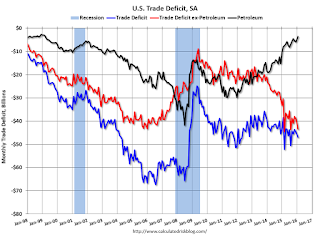Other key indicators include April vehicle sales, the April ISM manufacturing and non-manufacturing indexes, and the March trade deficit.
 10:00 AM: ISM Manufacturing Index for April. The consensus is for the ISM to be at 51.5, down from 51.8 in March.
10:00 AM: ISM Manufacturing Index for April. The consensus is for the ISM to be at 51.5, down from 51.8 in March.Here is a long term graph of the ISM manufacturing index.
The ISM manufacturing index indicated expansion at 51.8% in March. The employment index was at 48.1%, and the new orders index was at 58.3%.
10:00 AM: Construction Spending for March. The consensus is for a 0.5% increase in construction spending.
2:00 PM ET: the April 2016 Senior Loan Officer Opinion Survey on Bank Lending Practices from the Federal Reserve.
 All day: Light vehicle sales for April. The consensus is for light vehicle sales to increase to 17.3 million SAAR in April from 16.6 million in March (Seasonally Adjusted Annual Rate).
All day: Light vehicle sales for April. The consensus is for light vehicle sales to increase to 17.3 million SAAR in April from 16.6 million in March (Seasonally Adjusted Annual Rate).This graph shows light vehicle sales since the BEA started keeping data in 1967. The dashed line is the March sales rate.
7:00 AM ET: The Mortgage Bankers Association (MBA) will release the results for the mortgage purchase applications index.
8:15 AM: The ADP Employment Report for April. This report is for private payrolls only (no government). The consensus is for 193,000 payroll jobs added in April, down from 200,000 added in March.
 8:30 AM: Trade Balance report for March from the Census Bureau.
8:30 AM: Trade Balance report for March from the Census Bureau.This graph shows the U.S. trade deficit, with and without petroleum, through February. The blue line is the total deficit, and the black line is the petroleum deficit, and the red line is the trade deficit ex-petroleum products.
The consensus is for the U.S. trade deficit to be at $41.4 billion in March from $47.1 billion in February.
10:00 AM: the ISM non-Manufacturing Index for April. The consensus is for index to increase to 54.7 from 54.5 in March.
10:00 AM: Manufacturers' Shipments, Inventories and Orders (Factory Orders) for March. The consensus is a 0.6% increase in orders.
8:30 AM: The initial weekly unemployment claims report will be released. The consensus is for 262 thousand initial claims, up from 257 thousand the previous week.
8:30 AM: Employment Report for April. The consensus is for an increase of 200,000 non-farm payroll jobs added in April, down from the 215,000 non-farm payroll jobs added in March.
The consensus is for the unemployment rate to decline to 4.9%.
 This graph shows the year-over-year change in total non-farm employment since 1968.
This graph shows the year-over-year change in total non-farm employment since 1968.In March, the year-over-year change was 2.80 million jobs.
A key will be the change in real wages.
3:00 PM: Consumer credit from the Federal Reserve. The consensus is for a $15.8 billion increase in credit.
from
http://feedproxy.google.com/~r/CalculatedRisk/~3/jV-Yhls_reg/schedule-for-week-of-may-1-2016.html



















